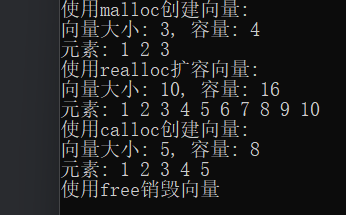动态数组与其在C语言中的实现
在C语言中,数组是一片连续的内存空间,这片内存空间被划分为大小相等的小空间。在介绍动态数组之前,让我们先简单回顾一下数组的基本特性。
数组的优点
- 访问速度快:可以通过下标索引直接访问元素,时间复杂度为O(1)。
- 内存连续:有利于局部性原理,高速缓存命中率高。
数组的缺点
- 大小固定:数组大小必须在声明时确定,之后无法改变。若数组空间不够,需要重新定义更大的数组。
- 空间静态分配:若申请了较大的数组但实际使用较少,会造成内存浪费。
- 插入和删除效率低:需要移动大量元素,时间复杂度为O(n)。
为了克服数组的上述缺点,我们引入了动态内存分配的概念。
为什么需要动态内存分配?
- 栈空间有限, 不适合存放大数据。
- 栈帧大小在编译期间确定, 栈空间不能存放动态大小的数据。
- 每个线程都有自己的栈, 不适合存放多线程共享的数据。
常见的内存分配函数有malloc, calloc, realloc, free。接下来我们将通过一个实例来展示如何在C语言中实现动态数组。
C语言实现动态数组
首先,我们需要定义一个动态数组的结构体和相关操作。这些操作包括创建数组、添加元素、删除元素、增长容量以及销毁数组。
1
2
3
4
5
6
7
8
9
10
11
12
13
14
15
16
17
18
19
|
#include <stdlib.h>
typedef int E;
typedef struct {
E* elements;
int size;
int capacity;
} Vector;
Vector* vector_create(void);
Vector* vector_create_calloc(void);
void push_back(Vector* v, E val);
void push_front(Vector* v, E val);
E pop_back(Vector* v);
E pop_front(Vector* v);
void grow_capacity(Vector* v);
void vector_destory(Vector* v);
|
接下来,我们实现这些函数。
1
2
3
4
5
6
7
8
9
10
11
12
13
14
15
16
17
18
19
20
21
22
23
24
25
26
27
28
29
30
31
32
33
34
35
36
37
38
39
40
41
42
43
44
45
46
47
48
49
50
51
52
53
54
55
56
57
58
59
60
61
62
63
64
65
66
67
68
69
70
71
72
73
74
75
76
77
78
79
80
81
82
83
84
85
86
87
88
89
90
91
|
#include "vector.h"
#include <stdio.h>
#include <stdlib.h>
#define DEFAULT_CAPACITY 4
#define PREALLOC_MAX 1024
Vector* vector_create(void) {
Vector* v = malloc(sizeof(Vector));
if (!v)
{
printf("Error: malloc fail in vector_create\n");
exit(1);
}
E* p = malloc(sizeof(E) * DEFAULT_CAPACITY);
if (!p)
{
printf("Error: malloc fail in vector_create\n");
exit(1);
}
v->elements = p;
v->capacity = DEFAULT_CAPACITY;
v->size = 0;
}
Vector* vector_create_calloc(void) {
Vector* v = calloc(1, sizeof(Vector));
if (v == NULL) {
printf("Error: calloc failed\n");
exit(1);
}
v->elements = calloc(DEFAULT_CAPACITY, sizeof(E));
if (v->elements == NULL) {
printf("Error: calloc failed\n");
exit(1);
}
v->capacity = DEFAULT_CAPACITY;
v->size = 0;
return v;
}
void grow_capacity(Vector* v) {
int new_capacity = v->capacity < PREALLOC_MAX ?
v->capacity << 1 : v->capacity + PREALLOC_MAX;
E* p = realloc(v->elements, new_capacity * sizeof(E));
if (!p)
{
printf("ERROR: grow_capacity");
exit(1);
}
v->elements = p;
v->capacity = new_capacity;
}
void push_back(Vector* v, E val) {
if (v->capacity == v->size)
{
grow_capacity(v);
}
v->elements[v->size++] = val;
}
void push_front(Vector* v, E val) {
if (v->capacity == v->size)
{
grow_capacity(v);
}
v->size++;
for (int i = v->size - 2; i > 0; i--)
{
v->elements[i + 1] = v->elements[i];
}
v->elements[0] = val;
}
E pop_back(Vector* v) {
return v->elements[v->size--];
}
E pop_front(Vector* v) {
int t = v->elements[0];
for (int i = 0; i < v->size - 1; i++)
{
v->elements[i] = v->elements[i + 1];
}
v->size--;
return t;
}
void vector_destory(Vector* v) {
free(v->elements);
free(v);
}
|
现在,我们可以在主函数中测试我们的动态数组了。
1
2
3
4
5
6
7
8
9
10
11
12
13
14
15
16
17
18
19
20
21
22
23
24
25
26
27
28
29
30
31
32
33
34
35
36
37
38
39
40
41
42
|
#include <stdio.h>
#include "vector.h"
void print_vector(Vector* v) {
printf("向量大小: %d, 容量: %d\n", v->size, v->capacity);
printf("元素: ");
for (int i = 0; i < v->size; i++) {
printf("%d ", v->elements[i]);
}
printf("\n");
}
int main(void) {
printf("使用malloc创建向量:\n");
Vector* v1 = vector_create();
push_back(v1, 1);
push_back(v1, 2);
push_back(v1, 3);
print_vector(v1);
printf("使用realloc扩容向量:\n");
for (int i = 4; i <= 10; i++) {
push_back(v1, i);
}
print_vector(v1);
printf("使用calloc创建向量:\n");
Vector* v2 = vector_create_calloc();
push_back(v2, 1);
push_back(v2, 2);
push_back(v2, 3);
push_back(v2, 4);
push_back(v2, 5);
print_vector(v2);
printf("使用free销毁向量\n");
vector_destory(v1);
vector_destory(v2);
return 0;
}
|
运行上述代码,我们得到以下输出结果:

下面我们来一个简单的总结,并讲两点注意事项:
malloc函数分配的内存块包含未初始化的垃圁数据,而calloc函数分配的内存块会被自动初始化为0。malloc函数只接受一个参数,即要分配的字节数。而calloc函数接受两个参数,一个是要分配的元素的数量,另一个是每个元素的大小。这使得calloc更适合用于数组的分配。- 由于
calloc会初始化分配的内存,所以它可能比malloc稍微慢一些,尤其是在分配大量内存时。
注意事项
- use after free
- double free




